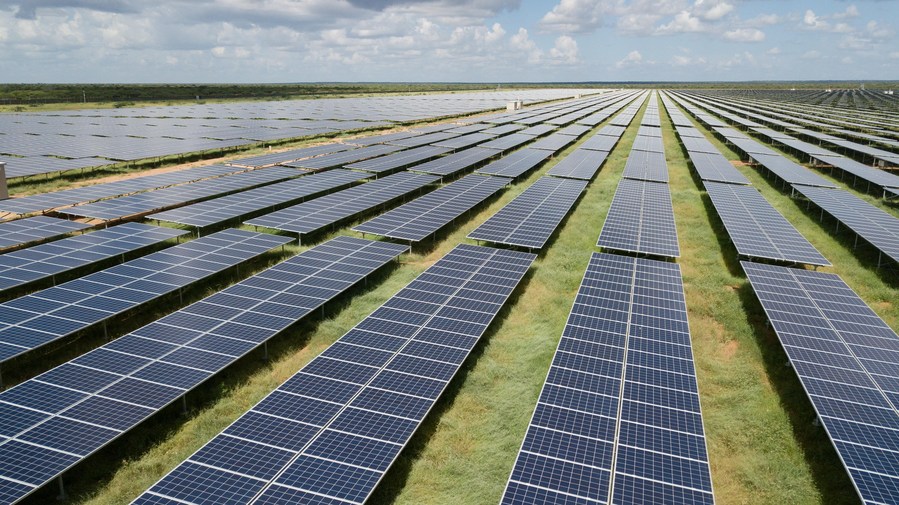
A view of Yangpu port in the Yangpu Economic Development Zone in Danzhou, Hainan Province, southern China, July 22, 2022. /Xinhua
A view of Yangpu port in the Yangpu Economic Development Zone in Danzhou, Hainan Province, southern China, July 22, 2022. /Xinhua
Editor's note: Cherry Hitkari, a special commentator for CGTN, is an Advisory Board member at Modern Diplomacy. The article reflects the author's opinions and not necessarily the views of CGTN.
Initially conceived as the "Silk Road Economic Belt" and the "21st Century Maritime Silk Road" in 2013 by Chinese President Xi Jinping, the Belt and Road Initiative (BRI) seeks to connect "the vibrant East Asian economic circle at one end and developed European economic circle at the other" and enhance intra- and inter-regional connectivity through a series of land and maritime infrastructure projects, trade agreements and investments that span cooperation in cyberspace, blue economy and people-to-people exchanges.
According to the World Bank, once completed, the BRI could lessen travel times along economic corridors by 12 percent, augment trade between 2.7 percent and 9.7 percent, raise incomes by up to 3.4 percent and alleviate 7.6 million people out of extreme poverty.
China further prioritized promoting low carbon and green development under the BRI framework. This included signing a Memorandum of Understanding on building a green Belt and Road with the United Nations Environment Programme (UNEP) and more than 50 agreements on eco-environmental conservation with nations and international organizations.
Additionally, the Initiative for Belt and Road Partnership on Green Development was signed with 31 countries and a Belt and Road Energy Partnership (BREP) cemented with 32 countries (as of January 2023). The list can go on.
Beijing's white paper titled "China's Green Development in the New Era" (2023) notes that China has not only assisted BRI partners in building their environmental governance capacity and improving the living conditions of their populace, but has also trained 3,000 people hailing from more than 120 countries under the Green Silk Road Envoys Programme. Moreover, China has formulated a set of Green Investment Principles for the Belt and Road and Chinese enterprises have funded renewable energy projects including clean energy facilities in other BRI countries.
China has also worked with BRI partners to formulate the cooperation principles and concrete actions of the BREP that include facilitating communication and cooperation on energy policy, sharing of best technologies, personnel training, etc., to develop avenues for the transition to clean energy.

A 50-megawatt solar farm in Garissa, Kenya, December 13, 2019. /Xinhua
A 50-megawatt solar farm in Garissa, Kenya, December 13, 2019. /Xinhua
At the second Belt and Road Energy Ministerial Conference held in October 2021, China launched the Belt and Road Green Energy Cooperation Qingdao Initiative with the aim of encouraging investments in green and low carbon developmental projects. The framework also entails best practice cases of Belt and Road Energy Cooperation to be shared among the BRI partners.
It's worth noting that BRI continues to offer several opportunities and avenues for developing countries to attain green and sustainable development without compromising economic growth. First and foremost, China and the host countries must work together to make ecological sustainability the core principle of BRI and accord it the centrality that it deserves but lacks.
Second, China must come up with a pointed and targeted approach by not only collectively formulating an action plan with defined timelines under the green BRI framework, but must also set up a transparent environmental impact assessment mechanism to record and evaluate influence on the environment.
This can include separate action plans based on the unique geographical and environmental characteristics of the host nations such as a defined set of priorities and mitigation strategies for island nations, landlocked nations, etc.
Third, it is important to concretely incentivize the use of renewable and clean energy for the private sector under the BRI framework. Fourth, Beijing must prioritize sharing best available technologies and practices for environmental conservation with host nations. It can include joint research on combating marine pollution and plastic waste, joint efforts to curb illegal, unregulated and unsustainable fishing, etc.
Fifth, China and other nations must diligently work together to de-escalate bilateral tensions and build conditions for cooperation. Sixth, China should closely engage with all countries to define basic tenets and standards of environmental governance to build a resilient regional and global infrastructure that takes into consideration the needs and aspirations of the developing world. Seventh, there is a pressing need to move away from the dominant anthropocentric development and diversify it to cater to the needs of wildlife and the environment at large.
It is none other than the United Nations that sees China as the "world's leader" in renewable energy and considers it a major player in combating climate change. If opportunities are exploited in a sustainable fashion, the BRI could prove to be a groundbreaking step in global environmental governance. Joint action on climate change is not just the pressing need of the hour, but has the potential to foster better political relations between nations.
Challenges are many and might entail long-drawn negotiations but as the Chinese saying goes: Although the road is long, one can certainly reach the destination if one tries; although the task is difficult, it will certainly be accomplished if one puts in efforts.
The past decade of the BRI has seen economic development, it is hoped that the decades to come see greater inclusivity in word and spirit.
(If you want to contribute and have specific expertise, please contact us at opinions@cgtn.com. Follow @thouse_opinions on Twitter to discover the latest commentaries in the CGTN Opinion Section.)